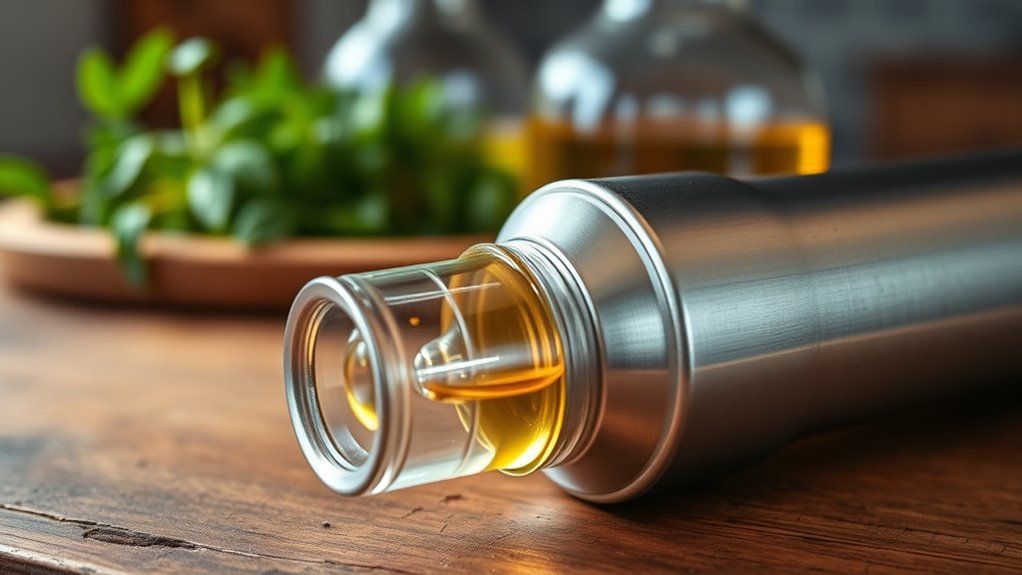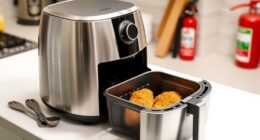Oil sprayers turn liquid oil into a fine mist, helping you cook more healthily and reduce waste. Look for models made from durable, BPA-free plastic, glass, or stainless steel to avoid harmful chemicals like BPA, which can leach into food. Choosing a sprayer with features like leak-proof design and easy cleaning will make your kitchen safer and more efficient. Keep exploring for tips on selecting the safest options and maintaining your sprayer properly.
Key Takeaways
- Choose BPA-free oil sprayers made from durable plastics, glass, or stainless steel to reduce chemical leaching and ensure food safety.
- Regularly clean and maintain your sprayer to prevent clogging, bacteria buildup, and ensure consistent misting performance.
- Be aware that plastic components can release harmful chemicals when heated or scratched; BPA-free does not guarantee chemical resistance.
- Eco-friendly options like glass bottles or stainless steel misters minimize plastic waste and are safer for both health and the environment.
- Opt for models with measurement windows and leak-proof designs for precise, safe, and efficient oil application during cooking.
Understanding How Oil Sprayers Work
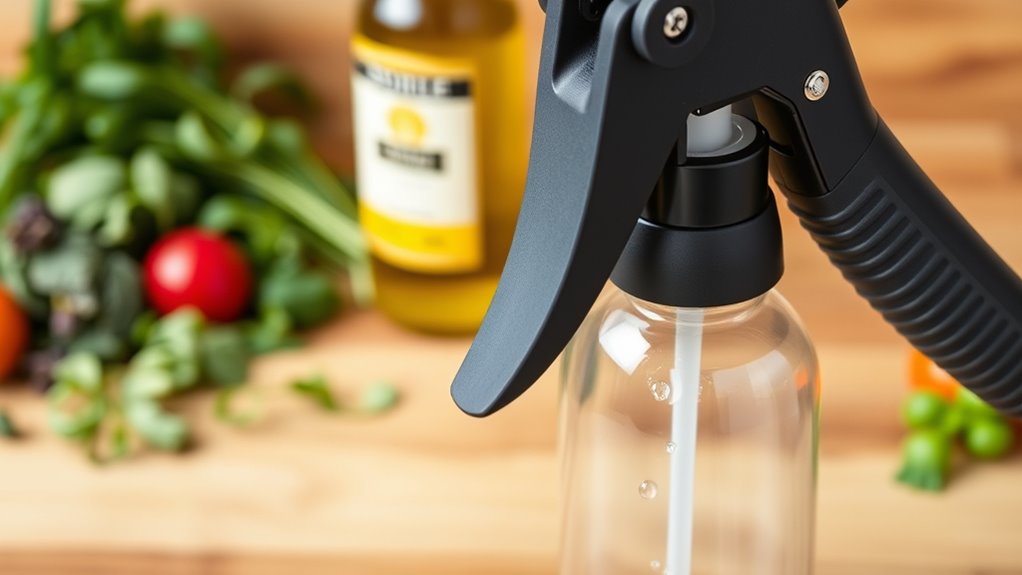
Oil sprayers work by converting liquid oil into a fine mist, making it easier to evenly coat pans, foods, or cooking surfaces. This process relies on the spray mechanism, which creates an oil mist that disperses a controlled amount of oil with each spray. When you press the trigger or button, the spray mechanism forces the oil through a small nozzle at high pressure, breaking it into tiny droplets. The result is a uniform oil mist that helps you control the amount of oil used, reducing waste and promoting healthier cooking. This technology ensures you get even coverage without excess oil pooling or uneven application. Understanding how the spray mechanism functions helps you choose the right oil sprayer for your cooking needs. Additionally, selecting a BPA-free oil sprayer is important for health and safety, as it minimizes chemical leaching into your food.
Common Materials Used in Oil Sprayers
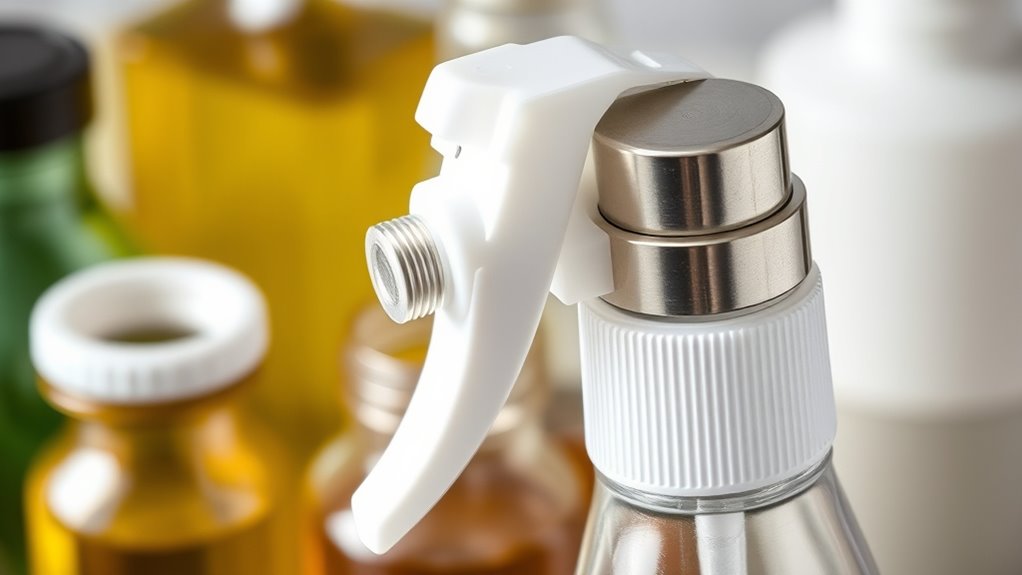
Many oil sprayers are made from plastic components, but not all plastics are BPA-free or safe. You might also find models crafted from metal or glass, which can offer different durability and safety benefits. Knowing these materials helps you choose a sprayer that suits your preferences and health concerns.
Common Plastic Components
Plastic components in oil sprayers are typically made from a variety of durable and lightweight materials designed to withstand frequent use. Common plastics include polypropylene, polyethylene, and sometimes polyethylene terephthalate (PET). These materials are selected for their resistance to corrosion and ease of manufacturing. However, over time, plastic degradation can occur, especially with exposure to oil and UV light, which might lead to chemical leaching. This leaching raises concerns about contamination and health safety. To help you evaluate options, consider these points:
- PP (Polypropylene): Known for chemical resistance and durability
- PE (Polyethylene): Cost-effective and flexible
- PET: Common in spray bottles, often BPA‑free
- Potential for plastic degradation: Can compromise safety over time
- Material compatibility: Understanding how plastics interact with oils and light exposure can help select a durable container.
Choosing plastics that minimize chemical leaching keeps your oil sprayer safe and BPA-free.
Metal and Glass Options
Metal and glass options are popular choices for oil sprayers because they offer durability and safety. Metal provides excellent durability, resisting cracks and impact, making it ideal for long-term use. Look for high-quality stainless steel or aluminum to guarantee metal durability. Glass, on the other hand, boasts superior glass clarity, allowing you to see the oil level easily. Glass containers are also non-reactive, preventing any potential chemical transfer to your oil. Both materials are free from BPA and other harmful chemicals found in some plastics. While metal and glass options might be heavier or more fragile than plastic, their longevity and safety make them worthwhile investments. Choosing these materials means you get a sturdy, safe, and environmentally friendly oil sprayer that lasts. Material safety is an important aspect to consider to ensure your health and the longevity of your kitchen tools.
The Risks of Plastic Contaminants in Kitchen Tools
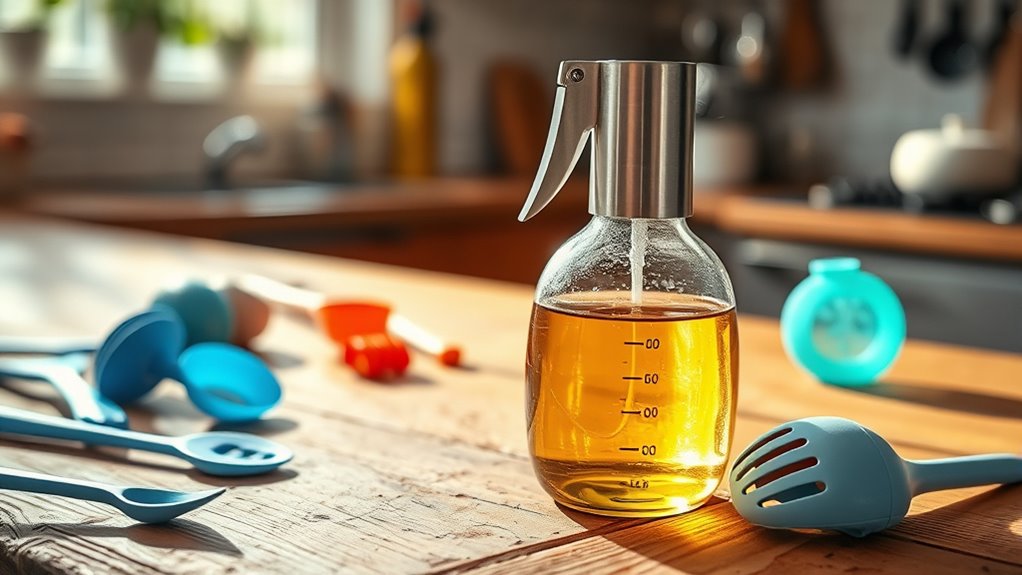
Although plastic kitchen tools are convenient, they can pose significant health risks due to chemical leaching. When heated or scratched, plastics may release harmful substances into your food, increasing your exposure to plastic pollution and chemicals. These chemicals can interfere with hormones and disrupt your health over time. Be aware of potential risks, such as:
- Release of BPA and other endocrine disruptors
- Increased chemical leaching with higher temperatures
- Microplastic particles contaminating your food
- Long-term health effects from repeated exposure
Choosing BPA-free plastics helps, but it doesn’t eliminate all risks. The best approach is to minimize contact with plastic tools, especially when cooking or storing hot foods. Being informed helps you make safer choices and protect your health from plastic contaminants. Additionally, self watering plant pots demonstrate that certain plastic products can be designed to reduce overexposure by controlling moisture levels and potential chemical contact.
What Does BPA-Free Really Mean?

Have you ever wondered what “BPA-free” really means on food containers and kitchen tools? It indicates the product doesn’t contain bisphenol A, a chemical linked to health concerns. However, it doesn’t automatically mean the material is more durable or sustainable. Here’s a quick comparison:
| Feature | BPA-Free Material |
|---|---|
| Oil sprayer durability | May vary; some plastics are less sturdy |
| Material sustainability | Often more eco-friendly, but not always |
| Chemical safety | Reduces BPA exposure, but check other additives |
| Longevity | Depends on quality and usage |
| Environmental impact | Usually better, but verify sourcing |
Choosing a BPA-free oil sprayer can improve material sustainability, but consider durability to ensure it lasts. Additionally, understanding cookie consent helps you manage online privacy preferences when researching product information.
The Benefits of Using BPA-Free Oil Sprayers
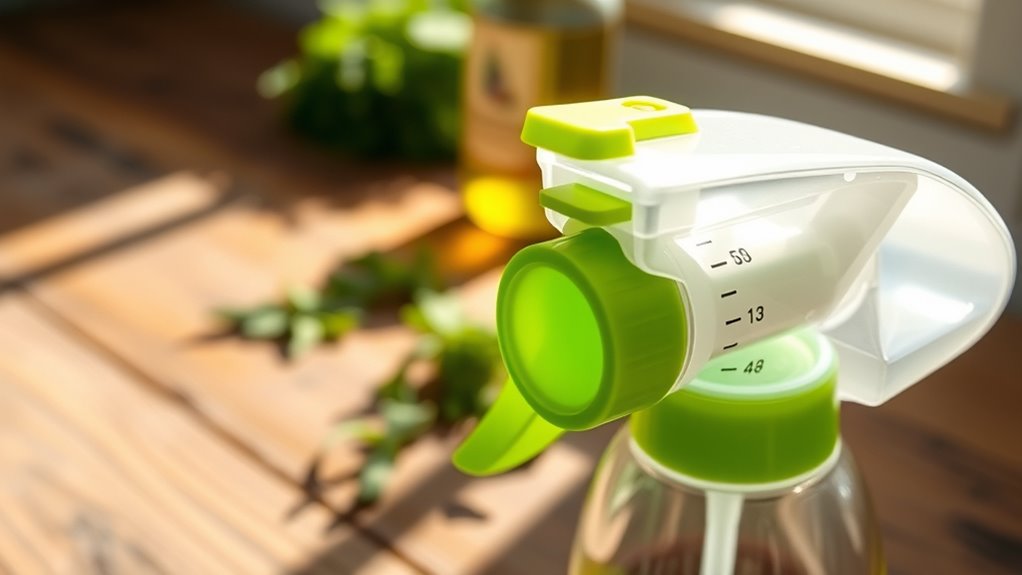
Using BPA-free oil sprayers offers several important benefits, especially when it comes to your health and the environment. By choosing BPA-free options, you reduce exposure to potentially harmful chemicals that can leach into your food. This promotes better health benefits, protecting you from endocrine disruptors and other toxins. Additionally, BPA-free sprayers often use safer materials that lessen the environmental impact, supporting sustainability.
Furthermore, embracing a creative practice mindset can help you make more informed choices and explore innovative solutions for your kitchen and lifestyle.
Features to Look for When Choosing a Safe Oil Sprayer
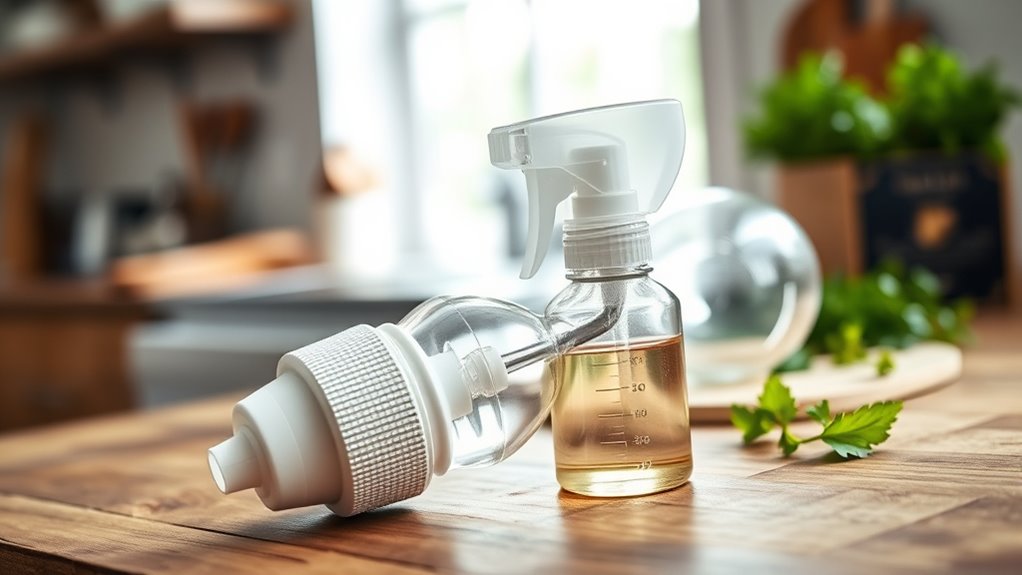
When selecting a safe oil sprayer, paying attention to key features can help guarantee you’re making a healthy and sustainable choice. Look for sprayers with a durable, non-leaking design to ensure oil doesn’t spill or waste. Opt for models made from BPA-free materials, which offer BPA free benefits and reduce health risks associated with plastic leaching. A clear, easy-to-read measurement window helps you control oil amounts and prevent overuse. Choose a sprayer with a consistent spray pattern to ensure even coating and better oil control. Comfortably designed, non-slip handles make usage easier and safer. Prioritize safety by selecting sprayers with secure lids and leak-proof seals. These features promote oil sprayer safety and help you enjoy healthier, more environmentally friendly cooking. Incorporating sound healing science principles into your kitchen environment can also enhance your overall well-being while cooking.
Tips for Proper Maintenance and Usage
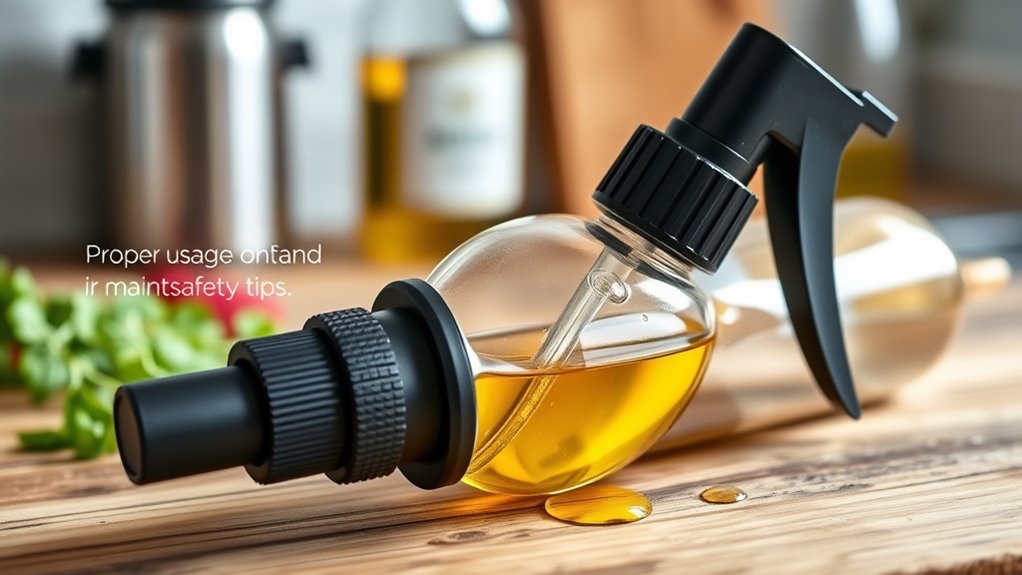
To keep your oil sprayer working well, you need a simple maintenance routine. Regularly cleaning it prevents clogs and buildup, ensuring even spray performance. Also, store it properly in a cool, dry place to protect its materials and extend its lifespan. For added durability, consider choosing a BPA-free model to avoid harmful chemicals.
Regular Cleaning Routine
Regular cleaning is essential to keep your oil sprayer functioning properly and guarantee food safety. Proper maintenance prevents clogs, ensures even spray, and extends the oil sprayer lifespan. To achieve this, follow these cleaning tips regularly:
- Rinse the nozzle with warm water after each use to prevent buildup
- Disassemble and scrub parts with a soft brush to remove residue
- Use mild soap or vinegar solution periodically for deep cleaning
- Dry all components thoroughly before reassembling to prevent mold
- Incorporate regular cleaning routines to maintain optimal performance and safety.
Proper Storage Practices
Proper storage practices help maintain your oil sprayer’s performance and safety over time. After using, make sure the sprayer is thoroughly cleaned and dried to prevent residue buildup, especially if you use olive oil, which can clog the nozzle. Store the sprayer in a cool, dark place away from direct sunlight, as heat can degrade the oil and damage BPA-free materials. Keep it upright in your kitchen storage to prevent leaks and spills. Avoid exposing the sprayer to temperature fluctuations, which can compromise its integrity. If you don’t plan to use it for a while, empty and clean the container to prevent mold or bacteria growth. Proper storage not only prolongs the lifespan of your oil sprayer but also helps keep your kitchen safe and organized. Reviews highlight the importance of selecting a durable, BPA-free material to ensure safety and longevity.
Eco-Friendly and Alternative Options for Oil Dispensing
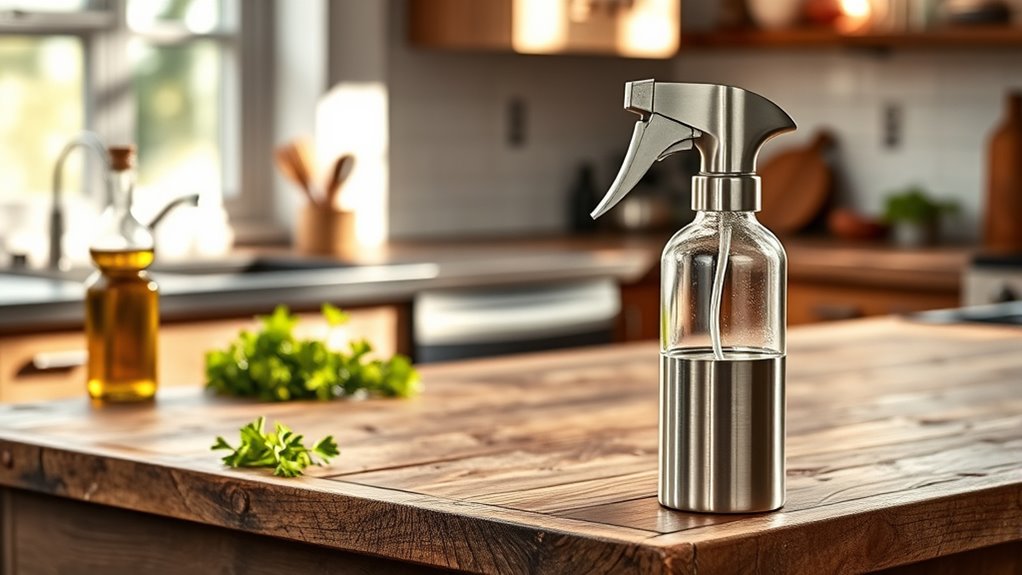
If you’re seeking eco-friendly and alternative ways to dispense oil, there are several options that reduce waste and avoid harmful chemicals. These alternatives focus on sustainable oil sprayer design and innovative methods of alternative dispensing. For example, you can use refillable glass bottles with drip-free spouts, which minimize plastic waste. Compostable or biodegradable spray caps are another eco-conscious choice, compatible with existing bottles. Oil misters made from stainless steel or ceramic materials offer durable, BPA-free options without relying on plastic components. Additionally, squeeze bottles made of silicone or other eco-friendly materials provide simple, effective alternative dispensing methods. These options help you reduce plastic waste, eliminate harmful chemicals, and still achieve even oil distribution in your cooking.
Frequently Asked Questions
Are All Bpa-Free Labels on Oil Sprayers Trustworthy?
You might wonder if all BPA-free labels on oil sprayers are trustworthy. Not necessarily. While BPA-free plastics are designed for plastic safety, some may still contain chemicals that leach into your food, especially with heat or over time. Always check for reputable brands and certifications to guarantee the sprayer minimizes chemical leaching, giving you peace of mind about plastic safety and healthier cooking.
Can Oil Sprayers Be Reused Safely Over Long Periods?
You can reuse oil sprayers safely over long periods if you prioritize proper cleaning and maintenance. Regularly rinse the spray mechanism with warm water to prevent clogs and buildup, and check for any leaks or damage. Avoid using harsh chemicals that could degrade the sprayer’s parts. With attentive cleaning and careful handling, your oil sprayer will maintain its long-term durability, ensuring safe and effective use over time.
How Do I Identify Genuine Bpa-Free Products?
You won’t believe how easy it is to spot genuine BPA-free products! Start with chemical testing—look for labels claiming BPA-free and verify if independent tests back that up. Check the brand reputation; trusted brands have transparent safety records. Don’t settle for fakes—inspect packaging for certifications and research reviews. By doing this, you’ll confidently choose products that are truly safe, avoiding harmful chemicals hiding in seemingly innocent containers.
Are There Health Benefits to Using Oil Sprayers?
Using oil sprayers offers health benefits by helping you control oil absorption, reducing excess intake. When you spray oil evenly, you limit the amount used, making meals healthier and lower in calories. This precise application encourages better portion control and minimizes unhealthy fats. Plus, using a BPA-free oil sprayer guarantees you’re not exposing yourself to harmful chemicals, supporting overall wellness while enjoying flavorful, well-prepared dishes.
Do Different Oils Require Different Types of Sprayers?
Think of your oil sprayer as a musical instrument—each oil’s unique viscosity demands a different tune. Thinner oils flow smoothly through delicate spray mechanisms, while thicker oils need a more robust system to prevent clogging. You must choose your sprayer based on oil viscosity, ensuring the spray mechanism matches the oil’s texture. This harmony guarantees even coverage and prevents frustrating blockages, making your cooking experience seamless and enjoyable.
Conclusion
Just like the explorers charting uncharted waters, choosing a BPA-free oil sprayer keeps your health and the planet in safe hands. By understanding how they work, the materials involved, and proper maintenance, you steer clear of hidden dangers. When you select eco-friendly options, you’re not only protecting yourself but also contributing to a cleaner, greener world—much like planting seeds for a healthier future, one spritz at a time.
